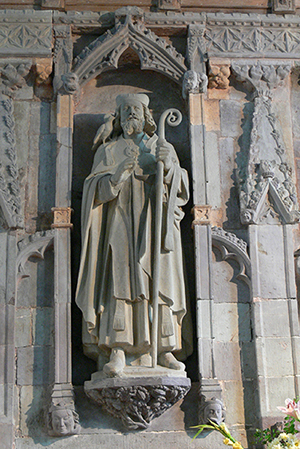 Statue of St David at St David's Cathedral
In 2000 the National Assembly for Wales voted unanimously to make St David’s Day on the 1st March a bank holiday. Sadly for those of us who live in Wales and would quite like an extra day off work, the idea was rejected by Westminster. Nevertheless, St David’s position as the patron saint of Wales has only grown stronger since then, with parades and concerts now a staple part of the festivities each year.
Statue of St David at St David's Cathedral
In 2000 the National Assembly for Wales voted unanimously to make St David’s Day on the 1st March a bank holiday. Sadly for those of us who live in Wales and would quite like an extra day off work, the idea was rejected by Westminster. Nevertheless, St David’s position as the patron saint of Wales has only grown stronger since then, with parades and concerts now a staple part of the festivities each year.
St David’s status as a modern national icon is a good example of how easily myth can trump historical evidence (or rather the lack of it). He lived and died fifteen hundred years ago, during a period of Welsh history often referred to as ‘the Age of the Saints’. The fifth and sixth centuries saw an intense bout of religious activity in Wales as holy men like David preached the word of God, founded churches and, if the monkish historians of the Middle Ages are to be believed, performed all manner of miracles.
Yet we have very little reliable information about who David was, what he did, or even when exactly he lived. It seems likely that his fame stemmed from the establishment of a monastery in modern-day Pembrokeshire in the late sixth century – a settlement which we know today as the cathedral-city of St Davids. However the earliest direct references to him are found in manuscripts dating from the eighth century, almost 200 years after his death, so it is difficult to be sure about much else.
Luckily the Welsh have never been inclined to let a lack of evidence get in the way of a good story. In the eleventh century a churchman called Rhygyfarch wrote a biography of David, and it is from this text that the mythical saint we know today begins to emerge. According to Rhygyfarch, David dedicated his life to preaching, pilgrimage and the foundation of churches. Numerous miracles are attributed to him, the most well-known of which involved the ground beneath his feet swelling upward so that he could be seen as he preached to a crowd. He also cured blind men and ate poisoned bread without harm. Lightning is even said to have struck the ground at the place and moment of his birth. Yet Rhygyfarch also gave David a reputation for abstinence from worldly pleasures – his followers were not allowed to eat meat or, even worse, drink beer!
It is worth remembering, however, that in the eleventh century the bishopric of St David’s was seeking to assert its authority over much of south and west Wales. Rhygyfarch was closely associated with the bishopric, and it is likely that by eulogising its founder he was trying to support those efforts. This medieval take on political spin was a success. In 1120 the Pope formally recognised David as a saint of the Catholic Church, and in the early thirteenth century St Davids came within a hair’s breadth of being elevated to the lofty status of an archbishopric.
 St David is often associated with the humble leek
Rather more prosaically, David is also associated with that most mundane of vegetables: the leek. According to legend, he directed a muster of Welsh warriors to wear leeks on their helmets in battle against the hated Saxons. Protected by these righteous leeks, the Welsh triumphed against overwhelming odds. This story was given a boost in 1599 when Shakespeare’s Henry V wore s leek at Agincourt as a sign of solidarity with his Welsh bowmen. Even today, on the 1st March serving soldiers in Welsh regiments wear the leek as their cap badge. Civilians, on the other hand, seem to prefer the daffodil – it’s not hard to see why.
St David is often associated with the humble leek
Rather more prosaically, David is also associated with that most mundane of vegetables: the leek. According to legend, he directed a muster of Welsh warriors to wear leeks on their helmets in battle against the hated Saxons. Protected by these righteous leeks, the Welsh triumphed against overwhelming odds. This story was given a boost in 1599 when Shakespeare’s Henry V wore s leek at Agincourt as a sign of solidarity with his Welsh bowmen. Even today, on the 1st March serving soldiers in Welsh regiments wear the leek as their cap badge. Civilians, on the other hand, seem to prefer the daffodil – it’s not hard to see why.
The cult of St David was widespread throughout the Middle Ages, and the shrine supposedly containing his remains at St Davids was a popular destination for pilgrims throughout the medieval period. Indeed from the twelfth century onwards, three pilgrimages to St Davids were reckoned the equal of one trip to the birth-place of Christ himself in Jerusalem. But David’s stock fell dramatically at the Reformation. Protestant reformers took a dim view of saints and shrines, seeing them as Catholic superstition which distracted from the true worship of God. The growth of Methodism in Wales during the eighteenth and nineteenth centuries only served to further entrench such attitudes.
Oddly enough, the decline in church attendance since the mid-twentieth century has coincided with a restoration of David’s fortunes. Today the 1st March is more widely celebrated in Wales than it has been for almost five hundred years. This is perhaps because Wales’s patron saint is for many now an emblem of national identity rather than religious devotion. The fact that my daughter’s friends will all be wearing Welsh national costume to nursery this 1st March is a good example of that shift.

Rate and Review
Rate this article
Review this article
Log into OpenLearn to leave reviews and join in the conversation.
Article reviews